VINCENT SV-237MK Review: Fired up
The big, spacious sound of Vincent’s recently updated SV-237MK hybrid amplifier gets Noel Keywood all fired up. Read our VINCENT SV-237MK Review.
If you want to make a hybrid amplifier that combines the sound of valves with the power of solid-state, then this is a good way to do it. Vincent (Germany) has been making lovely-sounding hybrids – in my view – for a long time. The VINCENT SV-237MK I’m reviewing is a recent update on a long-standing model. You get a muscular 150-watt amplifier with a three-valve preamplifier – and digital inputs.
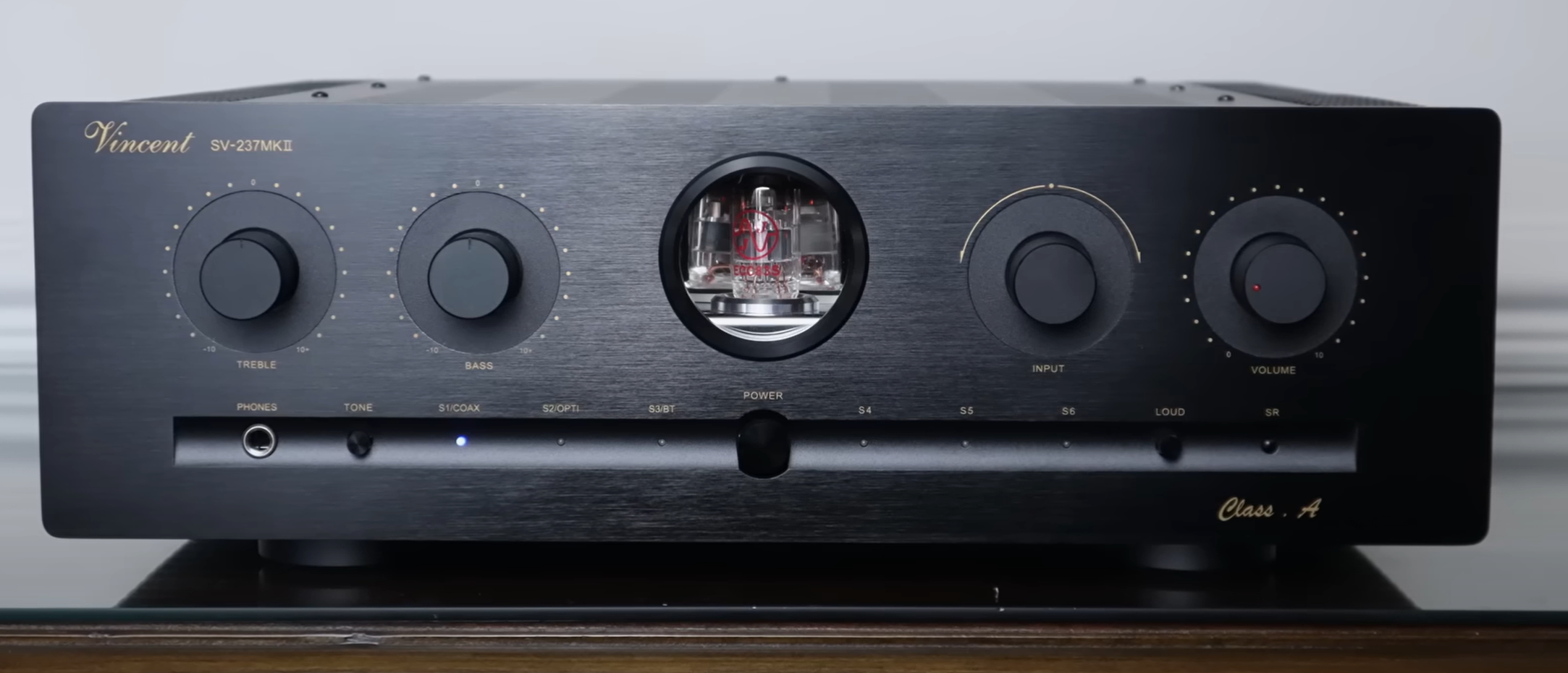
Although no valve output transformers exist, the amplifier is still large and heavy, weighing 20.4kgs. It houses a classic Class A/B amplifier with a big linear power supply and a massive toroidal mains transformer. No Class D, then, and no switch-mode power supply.
With a mains transformer so large to handle the power draw and feed the valves, the chassis is inevitably sizeable, measuring 430mm wide, 435mm deep, and 152mm high. It is also sturdily built, with 5mm thick machined alloy front panel, in our sample black anodised and with a brushed finish. Each side carries large heatsinks, and the top has an array of vents, but ours didn’t get hot under normal use. Cooling is done by convection; there are no fans, so there is no noise.
A major feature, of course, is the front panel window behind which sits one of the three valves, the 12AX7 double triode. It is lit by orange LEDs and is prominent from the moment of switch-on, making the Vincent look quite different from most others. After that come two 6NIP-EV triodes for higher voltage swing. I’ll mention quickly here that such small signal valves have a lifetime of 10,000 hours and cost little so there’s no big drawback in using them. And a new one is easy to plug in, should this ever be necessary.

At switch on, there’s quite a long delay, during which time an orange LED in the volume control knob flashes before the amplifier becomes active. Vincent stay with tradition by adding bass and treble controls at the left of the window and rotary input select and volume at the right of the window. Spinning the selector lights blue LEDs in sequence, sited in a trough below, machined out of the alloy panel.
They light in turn to show (left to right) – Coaxial digital input (S/PDIF), Optical digital input (S/PDIF), then S3 through to S6 – four analog inputs via RCA phono sockets; there is no balanced XLR input.
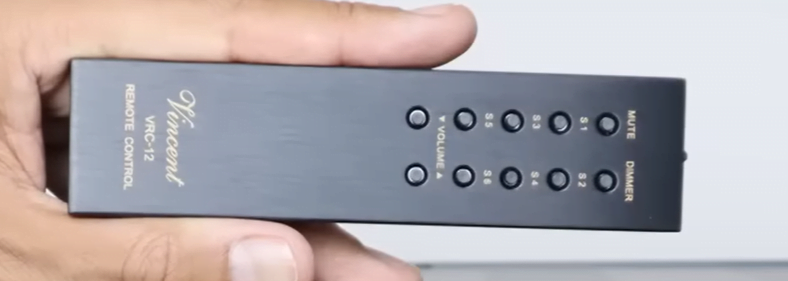
Vincent says they removed the USB and replaced it with S/PDIF upon user request since audio products use the latter, computers the former. Measurement showed the optical input (TOSLINK) accepts and works at up to 192kHz sample rate – important for hi-res players with optical-only outputs (Astell&Kern). Also fitted are Record Out (fixed volume) and Preamp Out (variable volume) sockets at rear, but there’s no Record In with A/B switching as of yore.
Two sets of large gold plated loudspeakers terminals are fitted, but there’s no switching between them; they are for bi-wiring or two rooms. There is a loudness button no less, that boosts bass and treble at low volume setting to compensate for the ear’s loss of sensitivity at frequency extremes, and also a defeat button (Tone) for the tone controls. At far left sits a 1/4in (6.3mm) headphone output jack that cuts out the loudspeakers when used.
With Tone on (i.e. the tone controls selected) +5dB of bass lift is applied I was surprised to find, not a nominally flat response as usual. Both the Tone and Loudness push buttons could have been sharper in their actions; I was uncertain whether they were in or out.
You can also see a Class A logo at right but the amplifier is Class A only up to a certain power output, often around 10 Watts or so, to prevent overheating.
A slim remote control carries input select, volume up/down, mute and a dimmer.
Of the digital section Vincent say nothing – a trifle odd. Peering inside I found a Burr Brown (Texas Instruments) PCM 5100A DAC, quoted (date 2012) as having a 100 dB dynamic range, a PCM 5101 and PCM 5102 offering 106dB and 112dB respectively. So Vincent have chosen a budget part here. Measurement revealed 101 dB dynamic range with 24 bit so you get CD quality, not the dynamic range expected from hi-res (115dB+). It’s a get-you- through addition then and I paid more attention to the main amplifier, feeding it digital from our Oppo UDP-205D Universal player (123dB dynamic range).
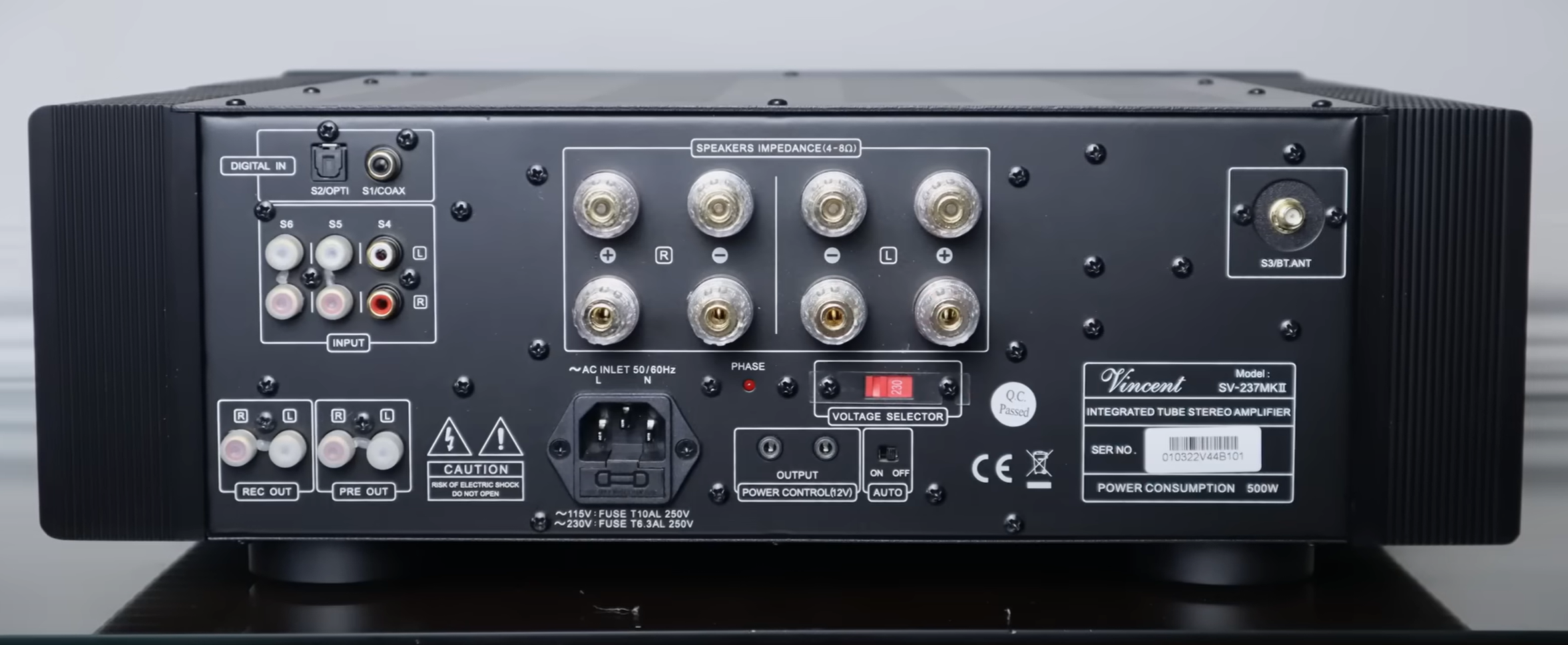
…all the lush openness of its predecessor and an easy delivery that was organically natural against most else
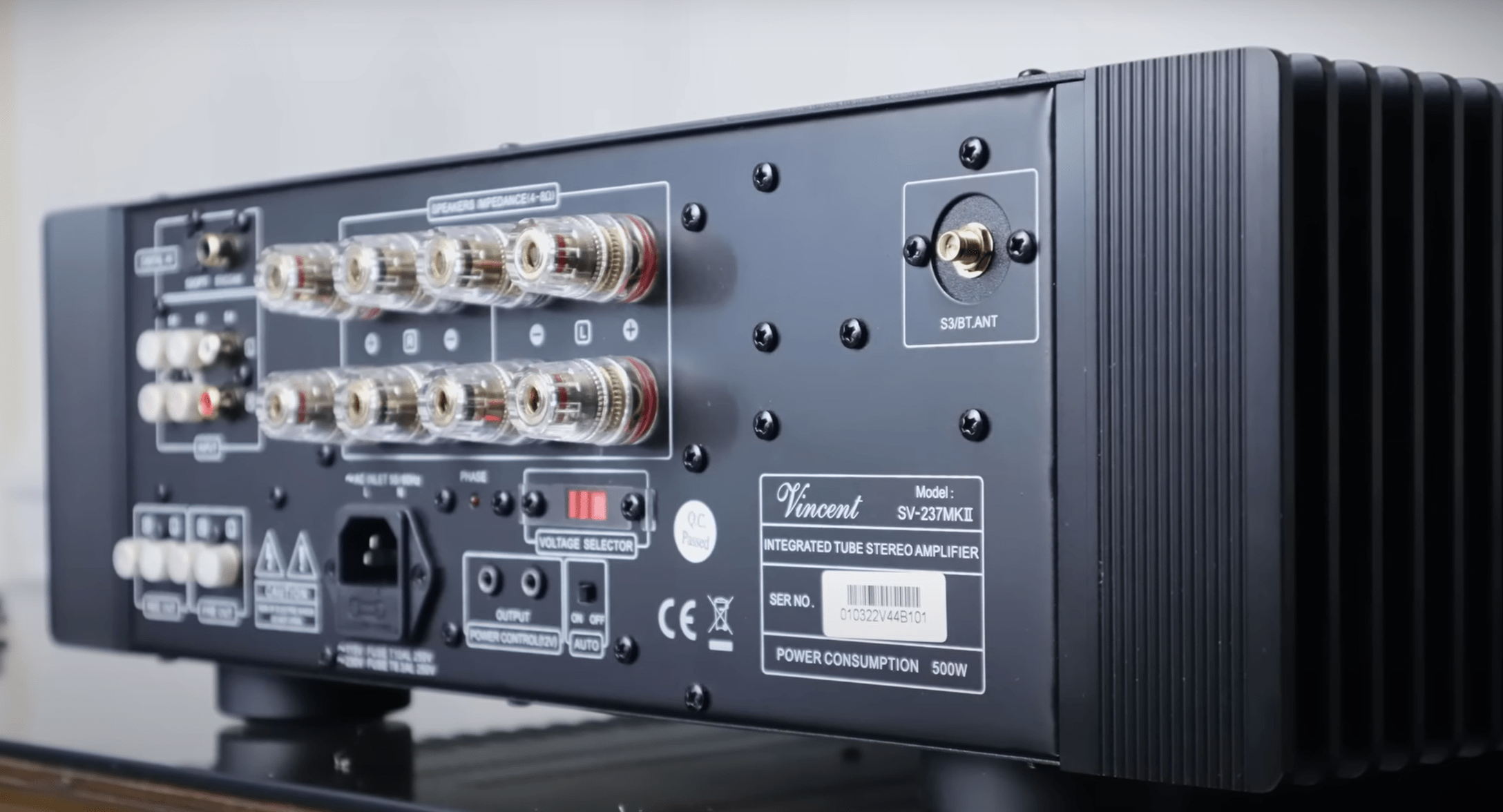
SOUND QUALITY
On sound quality the SV-237MK didn’t disappoint me, having all the lush openness of its predecessor and an easy delivery that came over as organically natural against most else. As always our Martin Logan ESL-X hybrid electrostatic loudspeakers lucidly revealed just what this amplifier was capable of – one notable feature being obvious yet easy going bass; in fact the sound was so fulsome I did walk over to ensure both Tone and Loudness were switched out. Music came from our Oppo UDP-205D Universal player connected to the analog input sockets.
With Antonio Forcione’s Tears Of Joy (uncompressed CD) the SV-237MK set his guitar in a lovely three-dimensional space and whilst the fast plucked strings had plenty of bite they weren’t sharp – as they are not if you listen to an acoustic guitar played live. The SV-237MK gets closer to the real thing – a beautifully rich but dynamic sounding acoustic than other amplifiers, without the slight bass bloom of an all-valve amplifier or the flat and mechanical sometimes coarse – sound of an all-transistor amplifier. One reason being it lacks crossover distortion our measurements show – obvious in its easy going treble.
Bass guitar was full and weighty in Josefine Cronholm’s In Your Wild Garden (uncompressed CD) yet moved along with laconic ease, making for a laid back presentation that was embracingly natural. Lots of thumbs up by others over this in the office – and I heard a sound quite unlike that from most other amplifiers, reminding me why previous Vincent products made such an impression.
Behind the front panel window is an alloy reflector surrounding the 12AX7 input valve – seen at right.
A large rear panel with an array of analog inputs at the left, plus digital inputs (S/PDIF) at the top. There is no USB for computer connection.
With Rimsky-Korsakov’s The Snow Maiden, Dance of the Tumblers (24/96) playing from an Astell&Kern AK I 20 portable hi-res player connected optically to the Oppo, the Minnesota Orchestra stretched wide across a sound stage graced by depth, strings rich, detailed and smooth. Strikes against the kettle drum had power and resonance, standing well apart from other instruments; this amplifier imposes strong dynamic separation.
Connecting the digital output of our Oppo CD player into the Vincent’s optical digital input, putting digital through its DAC rather than the ESS ES9018 Sabre32 series within the Oppo, brought a flat and digitally mundane sound; this is a get-you-through section. Vincent have put a lot into the amplifier’s architecture but there are better DACs to suit -without any big increase in price.
CONCLUSION
Vincent have honed the SV-237MK to give a pure yet texturally rich sound that’s smooth and relaxing.
Think deep sound stage and organic delivery. Bass was always strong yet note perfect and engaging. Big sound staging suited Rock and Classical equally. The digital section was unimpressive but I felt the basic hybrid amplifier – a well honed and complex design – more than made up for of its shortcomings. Few amplifiers match its uniquely beguiling sound.
The two 6N1P-EV triodes with spring retainers and ceramic bases.
MEASURED PERFORMANCE
Power from the Vincent SV-237MK measured 153 Watts into 8 Ohms and 256 Watts into 4 Ohms – a powerful amplifier able to go very loud.
Frequency response measured flat from 6Hz to 70kHz – wide. Distortion was low at all power outputs, the critical 1W at 10kHz figure – a measurement of crossover distortion – being just 0.02% of innocuous sounding second harmonic our analysis shows. The amplifier is linear, low in distortion and will give a clean sound.
The analog input needed 370mV for full output, so it isn’t particularly sensitive; volume will have to be turned up with low gain (MM = x100 / 40dB) external phono stages. There is no internal Phono stage.
The loudness control massively boosted bass and high treble at half volume and lower. Selecting the tone controls introduced +5dB bass boost with the controls set to zero.
Both digital inputs (S/PDIF) accepted 192kHz sample rate PCM, frequency response measuring flat to 20kHz before rolling down slowly to 96kHz, the upper limit of 192kHz sample rate – good.
Distortion with a hi-res 24bit input at -60dB measured 0.2% where 0.02% is possible and dynamic range was correspondingly poor at 101dB — CD quality in effect.
The amplifier section measured well, but the digital section gave CD quality with hi-res – unimpressive.
AMPLIFIER
Power 153W
Frequency response (-1dB) 6Hz-70kHz
Distortion (10kHz, 1W) 0.02%
Separation (1kHz) 94dB
Noise (IEC A) -92dB
Sensitivity 370mV
DIGITAL
Frequency response (-1dB) 5Hz-47kHz
Distortion (-60dB, 24bit) 0.2%
Dynamic range 101 dB
FREQUENCY RESPONSE
DISTORTION
VINCENT SV-237MK
OUTSTANDING – amongst the best.
VINCENT SV-237MK VERDICT
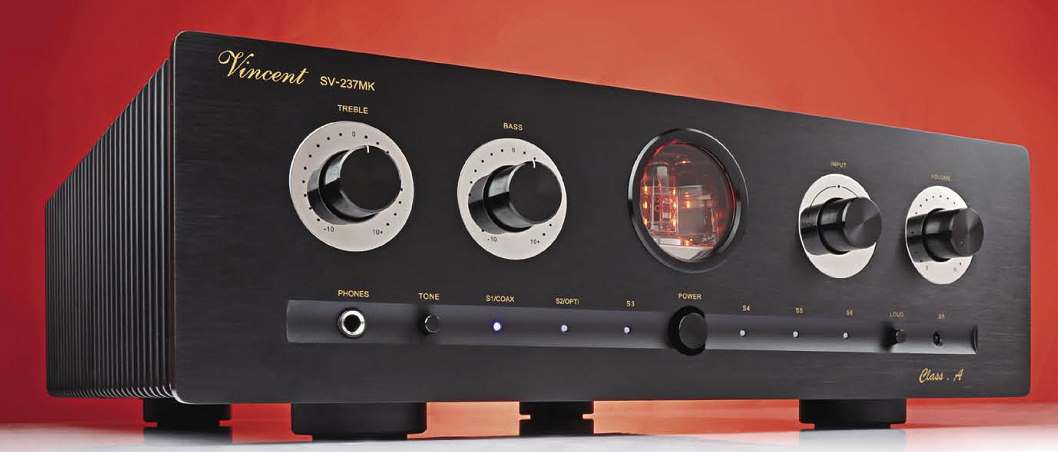





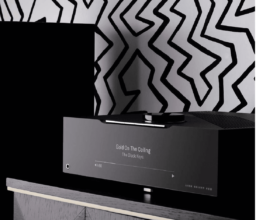
I’ve owned mine for over a year now. It’s good to see a professional review and one that I completely agree with. Vincent just doesn’t get the recognition the bigger names garnish but don’t let that fool ya this one hits beyond it’s price !!
thanks, you make my day! 😀
I found this review after much searching and pleased I did!
Live in Canada and want to try it now, Thanks ????
Thanks, you make my day ! 😀
Can a phono preamp be added for vinyl listening?
@Bob Christianson
Completely different Amps IMO, the Vincent is more SS and less tube like.
I owned a top range Prima Luna but prefer the Vincent for my style of music.
P.L more for slow moving orchestral & opera IMO.
The Vincent delivers a ton more power and pace and is more forward facing in its presentation, the PL being a little more spacious and 3D like but both are excellent.
The Vincent is like sitting front row facing the band/orchestra, the PL puts you in the middle of it.
The PL lacks the sheer grunt of the Vincent but the Vincent still sounds big wide and super clear.
For me, the Vincent wins.
Been living with mine for about a year now, couldn’t be more impressed.
Previously owned some way more expensive ‘named’ amps that although great, lacked the power of this beast.
This Vincent has it all, power, pace & finesse.
Im currently shopping and having a hard time deciding between the Vincent and a Primaluna EVO200. I have no opportunity to audition either. Please help and advise. My listening is diverse; ( Enigma, Metallica, Pink Floyd, EDM mixes). CD and digital files.
I purchased my SV237mk in April 2020 and the DAC chip has been upgraded to the PCM5102. The digital input sounds perfect now. After living with it for over a year now, this amp is everything the review describes and more. I was skeptical about the 12AX7 input stage and how much that contributed to the sound profile, but after rolling to a NOS RCA tube, WOW.
I just purchased my sv237mk in Australia. JAYO is right, 2021 build has DAC chip upgraded to PCM5102.
There are two more things for 2021 build:
1,the remote controller is now smaller (thinner) using cell battery, not the old one with 2*AAA (SRC-1) . Personally, the old remote controller feels better.
2, the tube changed to 12AX7 ECC83S 7025 JJ ELECTRONICS
The amp is almost perfect at this price. You can think of the preamp section is free for you.
Vincents are very good Amps for the money, most expensive and super expensive Amps, half the cost is in the chassis! I have the 228 Int. Amp and love it so far, and I now know you can tube roll with this unit, which can even make it better. Dac is not bad, and this Amp does a great job on 4ohm speakers, so, so on 8ohms depends on speaker. I just wish the Amp section had a tad more power coming in at 100Wpc at 8ohms and 180wpc at 4ohms. Runs my Dynaudio’s with easy along with SONUS FABER, but this is more of a back up Amp for me, but ton’s of fun!